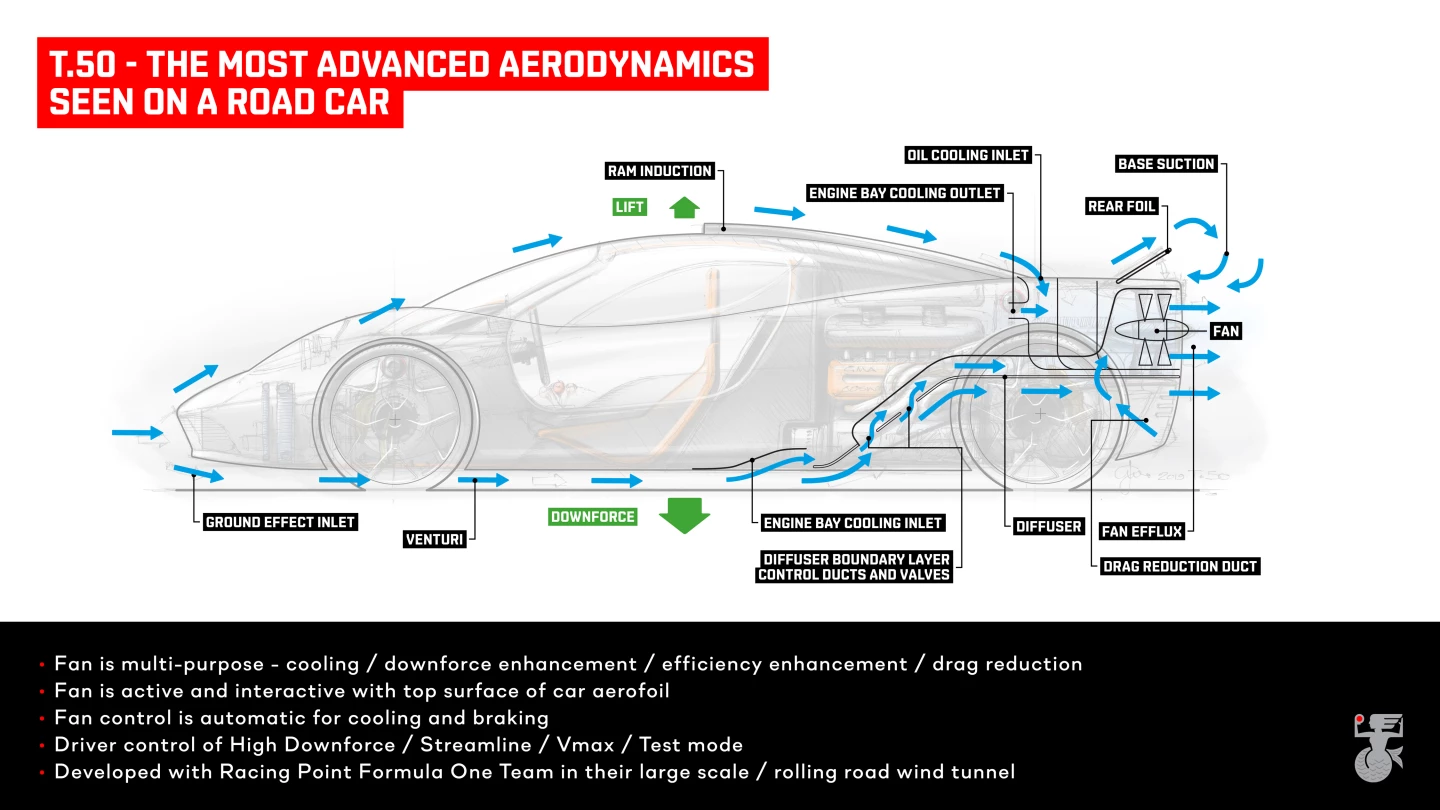It takes a lot to stand out in today's crowded super/hyper/uber/mega car market, but famed F1 designer Gordon Murray has found several ways to make his upcoming T.50 supercar a true contender without bothering to chase speed or power records. In new details released today, Murray expanded on his claim that the T.50 will have the most advanced aerodynamics of any road car, with its fan-forced system that literally sucks the car down onto the road, while pushing pressurized air out the back to reduce drag.
This is the first proper render we've seen on the T.50, and it shows in detail what the outrageous back-end of this car will look like: utterly dominated by the giant 400-mm (15.7-in) fan that rapidly accelerates air through from the underside of the car (using vertical ducts, so it doesn't vacuum up stones and gravel) and forces it through the engine cooling system, past an internal diffuser system, and out the back end.

The aero system, which also includes a pair of active rear aerofoils, will operate in no less than six different modes. The first two require no input from the driver. Auto mode senses the way you're driving and makes all the aerodynamic decisions for you, whereas Braking mode detects when you're really jumping on the picks, then pops up the rear aerofoils and runs the fan flat out to literally double the car's downforce. Murray says the extra grip can pull you up 10 m (33 ft) shorter when you're braking from 150 mph (241 km/h).
High Downforce mode doesn't go quite so far, but it still increases downforce by 30 percent to give you an edge in fast corners. Streamline mode closes the bottom vents to reduce downforce, and runs the fan flat out just to reduce drag, increasing the car's efficiency and straight-line speed with a "virtual longtail."
If you want to take it for a top speed run, you can select a further Vmax mode, which does the same as Streamline mode but runs the car's starter/generator flat out as well, to add 30 hp to the engine's crankshaft for a maximum of three minutes before the battery runs out.
The final aero mode is a Test mode, and that's the one that you'll be cranking up to show off to your mates, or cool down a hot bowl of noodles behind the car, or do Beyonce impressions.

We already knew the engine would be a naturally-aspirated Cosworth V12 with a screaming redline of 12,100 rpm – the highest-revving production street car engine ever built, by a long shot.
Indeed, the only other production car engines we're aware of that rev higher than 10,000 rpm are the 10,500 rpm Ariel Atom 500 V8 – and that's cheating, because it's really two Hayabusa motorcycle engines stuck together – and the insane 1,000-hp, 6.5-liter V12 that Cosworth is building for Aston Martin's Valkyrie, which revs at 11,100 rpm.
Now we know the T.50's final maximum power output is 700 hp, once that 48-volt starter/generator boost kicks in, and with high speed ram air in effect. The engine will be a 4-liter, 65-degree V12, with a manual 6-speed plus reverse transmission to give it the "analogue" driving experience Murray is going for. This car will be an absolute event to look at, ride in or listen to. Driving it around corners at a racetrack is going to require some strong neck muscles, it's going to stick like nothing else.
Like Murray's own design of the extraordinary McLaren F1, and its "spiritual successor" the space-age McLaren Speedtail, the T.50 will run a driver-centric cabin with the driver in the middle and two passengers behind and to the sides. The doors will be dihedral, opening upwards much like a McLaren's, and if you need any more reasons to convince you this thing will be truly special, consider the fact that it's targeted to weigh just 2,160 lb (980 kg).
A new partnership with the UK's Racing Point Formula One team will give the Gordon Murray Motors team access to one of the world's most advanced rolling road wind tunnel systems, to tweak and tune the T.50's insane aero setup in the run up to the model's official unveiling in May 2020.
There are apparently a few units still up for grabs out of the 100-car production allocation, at a price "in excess of UK£2 million" (US$2,630,000). So there's still a chance if you want to grab yourself a car that totally sucks.
Source: Gordon Murray Design









